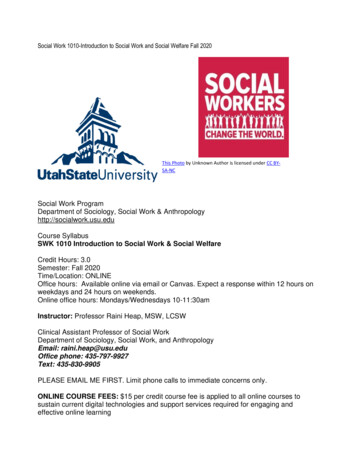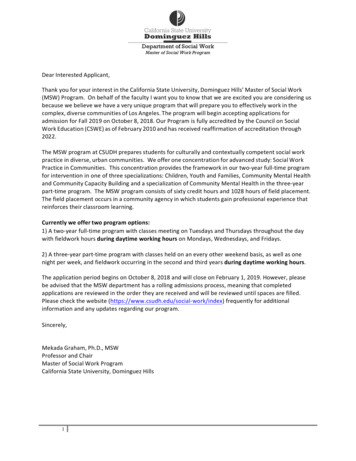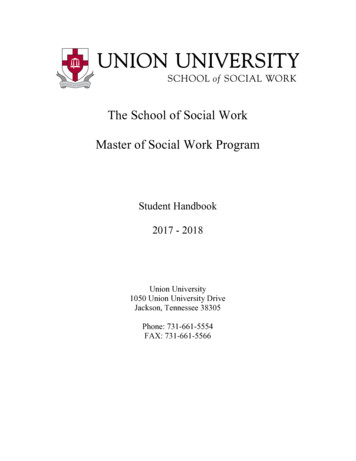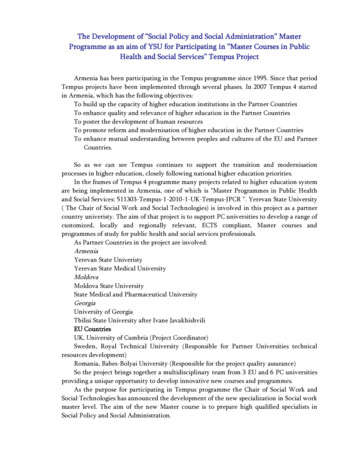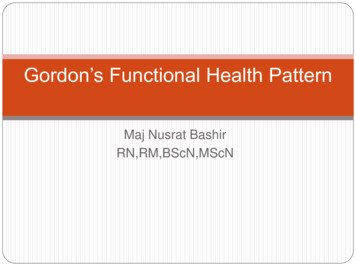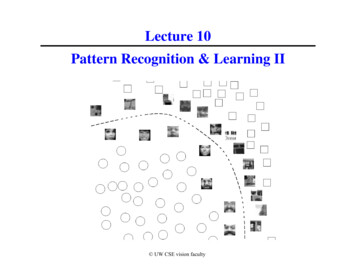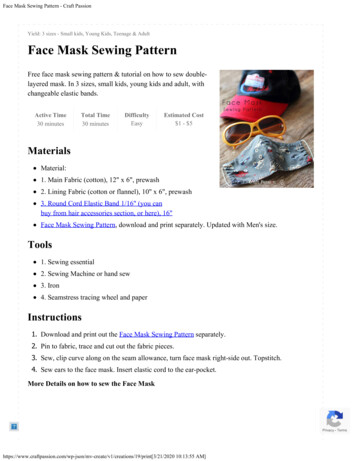
Transcription
International Journal of Research in Sociology and Anthropology (IJRSA)Volume 5, Issue 2, 2019, PP 32-43ISSN 005www.arcjournals.orgCommunication Pattern in Social Work Practice: A ConceptualFrameworkMd. Farukuzzaman1*, A. H. M. Mahbubur Rahman2 Ph. D.1Lecturer in Social Work, Mohammadpur Kendriya University College, Mohammadpur, Bangladesh2Associate Professor, Department of Social Work, Tejgaon College, Dhaka, Bangladesh*Corresponding Author: Md. Farukuzzaman, Lecturer in Social Work, Mohammadpur KendriyaUniversity College, Mohammadpur, BangladeshAbstract: Communication is a viable element that plays an important part in direct social work practice topromote, enhance and ensure social welfare services for individual, group and community clients withdiversity of problems across the societies. Purpose of the paper is to discuss basic forms, components,elements, and process of the communication with which social workers play a vital role in the helpingprocess exchanging information related to client’s needs, problems, contexts, environment, types of service,and about agency between social worker and client at individual, group and community level. In the light ofcommunication an indigenous model developed has been discussed and applied for social work practice.Keywords: Communication, Conceptual Framework, Social Work Practice1. INTRODUCTIONCommunication is one of our most pervasive, important and complex clusters of behavior. The abilityto communicate on a higher level separates human beings from other animals. Our daily lives arestrongly affected by our own communication with others as well as by massages from distant andunknown persons. If there is a need to know about the world, that need extend to all aspects of humanbehavior, especially communication. An understanding of methodical conception of communication isan important step toward becoming a more competent, adaptive individual (Littlejohn, 1983).Communication plays very important role in our lives. We depend on communication in every aspectof our lives, from our relationships with family and friends to our success in the workplace. Thecommunication may take place between individual, group, community and within globe. The wholeworld is connected by network through communication.We live in a fast-moving, push-button, space age; we find that people are sill the center of the worldand its values. The rocks, the stars, and the moon are very important but man is more important. Asmen and women live together, problem of relationship and interaction emerge. Personal problems,family problems and community problems appear on the horizon of everyday living (Skidmore &Thackeary, 1964).When serious difficulties in human relationships arise, the question immediately becomes “can we gethelp?” the answer is “yes”. Many professions and methods are ready for help, one of which is socialwork. Social work not only helps people to solve problems, but also assists them to prevent problemsand enrich daily living. The mail focus of social work is upon helping people to improve their socialfunctioning, their ability to interact and relate to others. Communication is very important part of socialwork. This article has been composed of the application of communication in social work practice.Generally, social work is scientific method of helping people to solve their problems and fulfill theirneeds in individual, group and community level. In doing so, communication with person inindividual, group and community level is necessity in the various phases of social work practice.Realizing the importance of communication, this study has been carried out to analyze its role insocial work practice. Secondary literature including Books, Journals, Government documents,Articles of newspaper and Website have been considered as the source of data in this study, whichwere then subject to content analysis and descriptive studies.International Journal of Research in Sociology and Anthropology (IJRSA)Page 32
Communication Pattern in Social Work Practice: A Conceptual Framework2. COMMUNICATION PATTERNCommunication is a process in which one individual conveys information – either intentionally ofunintentionally – to another. Communication is a form of behavior, but not all behavior iscommunication; it depends on whether a person perceives a massage in the words or behavior ofanother. Communication occurs when one person attaches meaning to the verbal or nonverbalbehavior of another (Sheafor and Horejsi, 2011). Communication has been defined as exchanginginformation, creating and maintaining relationships and sharing understanding with those around us.Because of its complex, multidisciplinary nature, communication is difficult to define. Humancommunication is essentially the process of exchanging our views or feelings with another person. Inits basic form, the process of communication is to express thoughts, feelings or information.Numerous definitions and conceptualizations of communication found in academic and professionalliterature by various components, such components are, symbolic, verbal, understanding, interactions,process, behaviour modifying response (table-1).Table1. Conceptual components in communicationComponentConception1. Symbols/Verbal/Speech “Communication is the verbal interchange of thought or idea” (Hoben, 1954).2. Understanding“Communication is the process by which we understand others and inturnendeavor to be understood by them. It is dynamic, constantly changing andshifting in response to the total situation.” (Anderson, 1959).3. Interaction/Relationship “Interaction, even on the biological level, is a king of communication;/Social Processotherwise common acts could not occur.” (Dead, reprinted, 1963).4. Process“Communication: the transmission of information, idea, emotion, skills, etc., by theuse of symbols -words, pictures, figures, graphs, etc. It is the act or process oftransmission that is usually called communication” (Berelson and Steiner, 1964).5. BehaviorModifying Communication is the discriminatory response of an organism to a stimulus”Response(Stevens, 1950).7. Linking/Binding“Communication is the process that links discontinuous parts of the livingworld to one another” (Ruesch, 1957).8. Commonality“It (communication) is a process that makes common to two or several whatwas the monopoly of one or some” (Gode, 1959).3. FORMS OF COMMUNICATIONCommunication takes place when someone thinks about something and talks to a friend or someoneelse, collaborates with a colleague in the workplace. Communication can be used to bring people closetogether, educate the public about an important issue. There are several forms of communication:3.1. Interpersonal CommunicationInterpersonal communication occurs between two people or in a small group of people. Interpersonalcommunication takes place between romantic partners, family members, friends and coworkers.Although interpersonal communication can take place in a small group of people, this type ofcommunication is generally between two people, and it takes place in an informal manner.3.2. Intrapersonal CommunicationIntrapersonal communication occurs when people communicate with themselves. Intrapersonalcommunication helps people increase their self-awareness, which allows them to communicate theirpersonalities and preferences to other people.3.3. Intercultural CommunicationIntercultural communication takes place between members of different cultures. Interculturalcommunication can occur between people from different ethnic, racial or socioeconomic backgrounds.It is particularly important in business, because many companies do business with others around theworld, and knowing about other cultures can make business interactions run smoothly.3.4. Organizational CommunicationOrganizational communication takes place among members of an organization. It occurs whencoworkers talk to one another in the break room, when employees get feedback from the boss during aperformance review and when colleagues discuss a project they are working on.International Journal of Research in Sociology and Anthropology (IJRSA)Page 33
Communication Pattern in Social Work Practice: A Conceptual Framework3.5. Small Group CommunicationSmall group communication generally takes place among five to 10 people. These groups formbecause the members of the group are charged with performing a specific task or to meet relationshipneeds. Examples of small group communication can be found in families, workplaces, therapy groupsand groups of friends.3.6. Mass CommunicationMass communication occurs when one source sends messages to many receivers in differentlocations. Mass communication includes print media, such as newspapers and magazines, and film,video, television, radio and the Internet. Compared to other forms of communication, masscommunication tends to be the most formal. The audiences of mass communication do not have a lotof opportunities to give feedback to a speaker.3.7. Public SpeakingPublic speaking, also called public communication, generally occurs in venues such as auditoriums,classrooms and conference halls. In the public speaking process, a speaker prepares remarks about acertain topic by doing research about the topic and the audience, writing the speech and practicing itsdelivery.4. PROCESS OF COMMUNICATIONThe process of communication falls into three categories--verbal, nonverbal and written. Althoughthey are each separate categories, they may be used independently or together during communication.The interpretation of any communication is dependent upon delivery and the environment in which itwas given.4.1. Verbal CommunicationVerbal communication is any type of words, sound, speech and language. The process of humancommunications starts at birth. Babies find a way to communicate using sounds to get their messageacross to adults. A baby will cry when uncomfortable or hungry.4.2. Nonverbal CommunicationThis type of communication in the process consists, in part, of gestures, facial expressions and bodylanguage. If you are telling someone a joke but have an angry expression on your face, you areconveying a mixed message. Similarly, if you are expressing love for another person with your armscrossed and maintaining a significant distance, this gives the impression you are not being truthful.Body language often leaves a stronger impression than words. For instance by smiling at anotherperson, we send a positive message without speaking at all.4.3. Written/Visual CommunicationWritten or visual communication includes the written word, drawings, songs, graphic design and video.This process of communication conveys an idea by being read or seen--relying on visuals. The possibilityof misinterpretation with written communication is abundant. A message is interpreted depending uponthe mood of the reader and the type of grammar, punctuation and style in which it is written.5. STEPS OF COMMUNICATION PROCESSCommunication is a process that one can learn to master and be more effective at carrying out.Understanding the steps of the communication process is essential to become a better communicator.Once someone understands the basic steps of the communication process, then can make a consciouseffort to communicate more effectively. While there are differing opinions as to how many steps thereare in the communication process, a basic five-step communication process is the most useful andeasiest to understand.5.1. The Idea or MassageThe very first step of communication process is the creation of the message or idea that a person wantto convey to others. Communication can occur on a number of different levels and in a variety ofdifferent formats. Therefore, it is necessary to choose how the idea is going to convey and to whom itwill be communicated as well. The idea or message must be appropriate for the type of audience andthe size of the audience.International Journal of Research in Sociology and Anthropology (IJRSA)Page 34
Communication Pattern in Social Work Practice: A Conceptual Framework5.2. Conveying the MessageOnce the idea has been created and the audience has been selected, then the next step of thecommunication process must be taken, which is to actually convey the message. The message can beconveyed in a number of different ways: verbally, in written form or through more subtle means suchas hands-on training. It is essential to choose the proper medium through which to transmit themessage. Selecting the right medium can affect how the message is received.Once the message has been transmitted to the chosen recipient and via the chosen medium, therecipient then receives the message. The reception of the message is important in the communicationprocess because the recipient ultimately determines if part or all of the message is received. Somepeople have selective hearing and may only hear part of what is said. Others may hear or read andremember every word. The extent to which the message is received plays an important role in the nextpart of the communication process.5.3. InterpretationThe interpretation of the message follows its reception. Once the message is received, the recipientthen determines what it means. If he has only heard part of the message or has a limited capacity forunderstanding the message, he may interpret it differently than it was intended. Even if the message isheard in its entirety, it can be misconstrued.5.4. Response and FeedbackThe recipient of the original message interprets the information and then formulates an appropriateresponse to the original message. The response depends largely upon the extent to which the originalmessage was heard or seen and whether or not it was properly interpreted. The type of responseultimately depends upon how the recipient interprets the original information and the type of response orinformation that the original person requests. This is where feedback is also important. If the message isnot heard or interpreted correctly, it is necessary for the original sender of the message to provideadditional feedback to the person receiving the message. This can only be done once the originalmessage has been interpreted. The original sender of the message must determine whether the recipientproperly interpreted the message and provide additional feedback to ensure proper interpretation.6. MODEL OF COMMUNICATIONIt is useful to look at a visual simplification of the complex relationships involved in communicationthrough models of communication. Here an interactional model of communication will be discussed,and that help to gain insight into the definition of communication and to work towards a betterunderstanding of communication process. In communication sender is the source or originator of themessage. The message is a verbal (spoken) or nonverbal (behavior or gesture) transmission of ideas.The sender goes through a process of encoding to translate ideas and emotions into a code (in our caseverbal or nonverbal symbols). The message is then passed to the receiver or the intended target of themessage. The receiver goes through a process of decoding to interpret the translated ideas of thesender. The passing of the message travels through a channel or pathway of communication. Thechannel can be anything from a text message to a face-to-face discussion to sky writing. Anything thatinterferes with the transmission of the message is considered noise. Noise consists of anything thatphysically or psychologically gets in the way of the message being received and understood. Physicalnoise is any outside or external stimulus that makes the message difficult to understand by thereceiver. Psychological noise is any internal stimulus that makes the message difficult to understandby the receiver. Feedback is a response from the receiver to the sender about the message (Figure-1).Figure1. Interactional Model of CommunicationInternational Journal of Research in Sociology and Anthropology (IJRSA)Page 35
Communication Pattern in Social Work Practice: A Conceptual FrameworkThere are many different models of the communication, but here are some of the key elements: the sender or communicator (the person who initiates a message)the receiver or interpreter (the person to whom a message is directed)the message (the verbal and/or nonverbal content that must be encoded by the sender and decodedby the receiver)the channel (the medium by which the message is delivered and received)the context (the setting and situation in which communication takes place)noise (anything that interferes with the accurate expression or reception of a message)feedback (a response from the receiver indicating whether a message has been received in itsintended form)Effective communication takes place when a sender's message is fully understood by the receiver.7. SOCIAL WORK PRACTICESocial Work is a scientific process and arts of helping people to solve their problems, to fulfill theirneeds, or to perform their social functioning in personal, group (specially family) and communitylevel by some specific methods to achieve satisfactory social functioning, and increase their ability tointeract well with others. Social work not only helps people to solve problems, but also assists them toprevent problems and enrich daily life (Skidmore and Thackeary, 1964). Social work is based uponthree premises: (1) that the man is important, (2) that his personal, family, and community problemsresulting from his interaction with others, and (3) that something can be done to alleviate his problems.Social work seeks to enhance the social functioning of individual, singly and in groups, by activitiesfocused upon their social relationships which constitute the interaction between man and hisenvironment. These activities can be grouped into three functions: restoration of impaired capacity,provision of individual and social resources, and prevention of social dysfunction.The term Social work practice generally refers to the practice of helping people use their socialenvironment to meet their needs and solve their problems. Social environment consists of family,friends, groups, organizations, agencies, and government etc. In helping process two parties areinvolved (1) social worker- a person who is trained in social work knowledge, values, skills and workfor an agency, or involve in private practice (2) client- may be a person, a group (family), and acommunity that is the focus of social work’s helping activity.7.1. Social Work Practice as Problem Solving ProcessSocial work practice is the problem solving process. Problem solving is the process by which thesocial worker examines the concern and need and identifies the blocks to need fulfillment. This leadsto problem identification and formulation and seeking solutions for problems. Now a day’s socialwork is very useful and complex method, having a wide variety of applications. Because of thecomplexity of social work practice, there are number of descriptions, approaches or perspectives, ofits nature and encounter clients with many different types of problems and concerns, it is not possibleto identify a single framework of practice that is superior to all others. However, a specific approachhas been developed with each subsequent edition and is referred to as an interactive-transactionalapproach to generalist social work practice. A generalist approach requires that the social workerassess the situation with the client and decide which system is the appropriate unit of attention, or thefocus of the work, for the change effort. As the unit of attention may be an individual, a family, asmall group, an agency or organization, or a community. There are five main phases of problemsolving process in social work practice and these includes7.1.1. EngagementEngagement is defined as the beginning phase in the helping relationship. In this phase the socialworker tries to identify, define, and describe the client’s concern, troublesome situation, or problem.First contacts between clients and workers can occur in different ways. The following terms arefrequently used to describe how clients may come into contact with agencies or social workers: Self-referral: A client may initiate contact with the agency themselves. Referral: Someone else refers the client to the agency.International Journal of Research in Sociology and Anthropology (IJRSA)Page 36
Communication Pattern in Social Work Practice: A Conceptual Framework Mandate Attendance: When people are mandated to attend an agency or they are legally obligedto go the agency.7.1.2. AssessmentAssessment is a complex process at the core of the service process. In this phase social worker collectdata to better understand the client’s concern or situation and its context. Assess and analyze theconcern and situation, and decide what needs to be changed or solved, and how it might be changed orsolved. Assessment, although a creative process, is also scientific in that it is a manifestation of theproblem-solving process. Some of its most important characteristics are the followings: It is ongoing,It is twofold, focusing both on understanding the client in the situation and in providing a basefor planning and action,It identifies needs in life situations, define problems, and explain their meaning and pattern,It identifies client strengths with an eye toward building on those strengths during intervention.7.1.3. Planning and ContractingPlanning is the bridge between assessment and activity focused on change. In this phase social workeridentify and agree upon the goals and objectives to be achieved by the process of change and thenformulate a relevant and realistic plan for reaching the goals and objectives. Once a tentative plan isbeing developed, it is important for the worker and client to agree or contact to take action about theplan. At a minimum, this contact should delineate the following: Problems or concerns to be address;Goals and objectives of the intervention;Activities the client will undertake;Activities to be performed by the social worker; andIdentification of additional persons, agencies, or organizations expected to participate andtheir role in the change process.7.1.4. Intervention and MonitoringIntervention is being considered as the action phase of the process, where the client and workercollaborate to implement change, and monitor progress of the intervention and determine if it isachieving the desired goals and if not, modify the action plan and try again. Intervention Activities: As the social worker engages a client in a helping relationship andintroduce the client to the process of change, he or she must select an appropriate practiceframework to guide this process. In addition, the worker must choose a number of specifictechniques and guidelines that are likely to facilitate and encourage the desire change.Monitoring Activities: Monitoring involves keeping watch over the changes or problem solvingprocess. Whenever possible, the social worker should share the result of this monitoring with theclient. When clients are aware of the changes that are occurring, whether positive or negative,they are more likely to involve themselves in the change process and come up with usefulmodification to the intervention plan.7.1.5. Evaluation and TerminationEvery helping relationship must end. The change process ends with the termination of service and afinal evaluation of the intervention. Once the goals and objectives have been reached or problemshave been solved or desire changes have been achieved, terminate the intervention and evaluate theproblem solving process form future practice activities. However, termination can take place at anypoint in the change process (figure-2); when the goals set by the worker and client have been reachedand the client feels comfortable in carrying out those goals without help form the worker, when theclient feel that sufficient help has been given so they can meet the need or deal with the problem ontheir own, when it becomes apparent that no progress is being made or that the potential for change ispoor, or when a worker or an agency does not have the resources needed by the client or does nothave the sanction of the agency to deliver the service needed. This last condition may result in aInternational Journal of Research in Sociology and Anthropology (IJRSA)Page 37
Communication Pattern in Social Work Practice: A Conceptual Frameworkreferral (Johnson: 1998). Each phase signposts a different stage of the helping process, although it cannever be assumed that the worker and client transaction proceeds in a linear fashion from engagementthrough to termination.Figure2. Termination and its place in the social work practice.Evaluation is also an important part of the termination process. Evaluation is the finding out of what isexpected to happen and is really happening. It looks at completed work and determine which methodsand strategies worked and why.7.1.6. Interactive view of social work practiceThe figure-3 presents a model of the key factors that influence the social work practice. It shows theclient and social worker in an effort to bring about a desire change in the client’s functioning orsituation, while both are being influenced by the social agency (e.g. its policies and programs) and bythe wider social environment. This planned change process involves several phases during which theclient and social worker move from their decision to initiate a course of action, although the socialworker is expected to guide this process, the client must ultimately decide to commit to the changeprocess and utilize the helping resources identified by or provided by the social worker.The client side of the figure indicates that the problem of situation the client seeks to change is, mostlikely, the product of a combination of personal and environmental factors. Each client has a uniqueset of personal characteristics (e.g., life experiences, goals, believes, perceptions, strengths, limitations,needs) and immediate environment (e.g., friends, families, school personnel, employers, neighborhoodor even other professional helpers) that may have contributed in some way to the situation or problembeing addressed and that might also be a resource that helps to bring about the desire change.Figure3. Interactive view of Social Work PracticeInternational Journal of Research in Sociology and Anthropology (IJRSA)Page 38
Communication Pattern in Social Work Practice: A Conceptual FrameworkThe social worker side of the figure suggested that the worker brings unique personal characteristicsand a professional background to the change process. These are experienced by the client throughwhat the social worker actually does. What the social worker does is a function of the specificprofessional re he/she has assumed and the conceptual framework he/she has selected to guide practice.The social work practice takes place within a social environment and more specifically, usually within the context of a social agency. Typically, the agency has been shaped by local, state, and/ornational social policies and its programs age a reflection of society’s values and beliefs. Finally, thesocial worker’s skills and mastery techniques, and the abilities, activities and decisions of client led tothe most evident and tangible phase of planned change process (Sheafor and Horejsi, 2011).7.2. Implication of Communication in Social Work PracticeThe social work practice or the helping process in social work carried out in interaction with clientand social worker, the interaction may be person to person or may involve systems of people. Thus, itis important for the social worker not only to have skills to use the social work process, but also beable to interact or communicate with client. The outstanding characteristic of the problem solvingprocess in social work practice is the inclusion of the client as much as possible in the work at eachstep of the helping process. Client expresses the need and concern that is the source of the problem.The purpose of communication in the social work interaction includes: Gathering information needed for the helping endeavor,Exploring ideas, feelings, and possible ways to meet and solve problems,Expressing feelings of thought,Structuring the work of the action system,Informing, advising, encouraging, and giving necessary directions.So, communication is an essential feature in all the phases of problem solving process.Communication plays the following roles in social work practice:7.2.1. Creating an Effective RelationshipA positive relationship between social worker and client is necessary, without a positive relationship,change is not likely to occur. The nature of a professional relationship is shaped by the reason why thesocial worker and client are meeting, the clients presenting concern or request, an agency’s programand procedures, and the practice framework by the social worker. To create helping relationshipeffective communication is very crucial.7.2.2. Better Understanding of Verbal and Non-verbal Behavior of ClientCommunication involves both a massage sender and a massage receiver. An essential feature ofcommunication is the sharing and structuring of experience through the use of verbal and nonverbalbehavior. The sender has a responsibility to convey his/her massage in a way that is easily receivedand understood. The receiver has a responsibility to make sure that he/she has accurately received thesender’s intended massage.Social worker make frequent use of two broad categories of verbal communication skills in socialwork practice (1) those intended to facilitate interpersonal helping and (2) those intended to facilitatethe exchanges of information within an agency, between agencies, and among professionals.The major types of communication occurs during face
and about agency between social worker and client at individual, group and community level. In the light of communication an indigenous model developed has been discussed and applied for social work practice. Keywords: Communication, Conceptual Framework, Social Work Practice *Corresponding Author: Md. F
